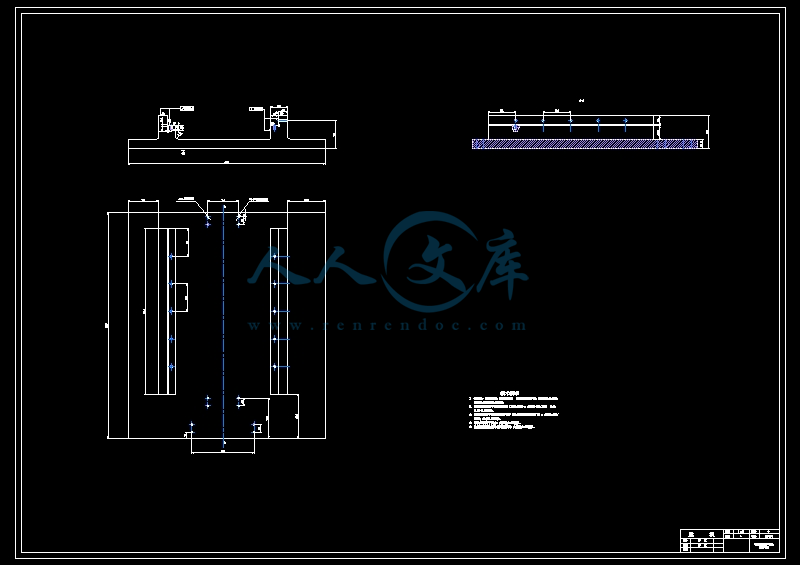【温馨提示】 购买原稿文件请充值后自助下载。
[全部文件] 那张截图中的文件为本资料所有内容,下载后即可获得。
预览截图请勿抄袭,原稿文件完整清晰,无水印,可编辑。
有疑问可以咨询QQ:414951605或1304139763
摘 要
随着制造业的发展,人们深刻的感受到数控机床在生产中的地位是越来越重要。本文结合机电一体化的需要,设计以单片机作为控制系统的X-Y型工作台(X-Y工作台是指能分别沿着X向和Y向移动的工作台)。通过对X-Y型工作台机械结构设计和控制电路接口的设计,阐述了机电一体化设计中的共性和关键技术。这种工作台通常与整机设计成一个整体,其形状,尺寸,结构因机器类型不同而有较大差异,但其工作原理有着共同点。
关键词:X-Y数控十字滑台;机电一体化;单片机
Abstract
Along with manufacturing industry development,people's profound feeling numerical control engine bed in production status is more and more important. Combine mechanical-electrical integration’s need, design a Model X-Y working bench with one-chip computer as the of the control system(X-Y working bench is separately along X and Y motion work table.). Though describing the working bench mechanical’s design of structure and interface of the control circuit to Model X-Y, have explained generality in the design of mechanical-electrical integration and its key technology. This kind of working bench is usually designed with the complete machine into a whole , its form , size, there is a greater difference because types of the machine are different in the structure, but its operation principle has common point.
Keywords: X-Y numerical control cross slippery platform; The mechanical-electrical integration; One-chip computer
目 录
1 绪论 1
1.1数字控制技术的产生和发展 1
1.2我国数控机床的发展情况 2
1.3数控机床中十字滑台的设计 2
2 机床改造总体方案设计 4
3 确定机械传动改造方案 5
3.1 设计原始参数 5
3.2 确定切削用量 5
3.3 进给运动的切削负载分析及计算方法 5
3.3.1、各个方向的分力 5
3.3.2、摩擦阻力 5
3.3.3、等效转动惯量计算 6
3.3.4、丝杠摩擦阻力矩的计算 6
3.3.5、等效负载转矩Tm的计算 6
3.3.6、起动惯性阻力矩的计算 6
3.3.7、步进电机输出轴总的负载转矩的计算 6
3.4 步进电机的匹配选择 7
3.5 滚珠丝杠的选择与校核 7
3.5.1、工作原理及结构 7
3.5.2、滚珠丝杠副的特点 7
3.5.3、承载能力的校核 8
3.5.4、压杆稳定性验算 8
3.5.5、刚度验算 8
3.6 齿轮的校核计算 9
3.7 轴承的选择与校核 12
3.8 导轨的选择 13
4 控制系统的硬件及软件设计 14
4.1 确定控制系统方案 14
4.2 单片机控制系统硬件设计 14
4.2.1、单片机控制系统的硬件构成 14
4.2.2、单片机引脚及其功能 15
4.2.3、控制线 15
4.3 单片机的选择 16
4.4 存储器的选用与扩展 16
4.5 存储器的选用及连接 16
4.6 地址锁存器 17
4.7 键盘与显示电路及其程序 18
4.7.1、8155工作方式设定 19
4.7.2、状态查询 20
4.7.3、8155定时功能 20
4.7.4、键盘显示电路工作原理 22
4.8 步进电机接口电路 29
5 总结 32
参考文献 33
致谢 34
1 绪论
1.1数字控制技术的产生和发展
最早采用数字控制技术进行机械加工的思想,是在20世纪40年代提出的。当时美国北密执安的一个小型飞机叶片轮廓样板时,利用全数字电子计算机对叶片轮廓的加工路径进行了处理,并考虑了刀具对加工路径的影响,使加工精度达到±0.0381mm。以当时的水平来看,是相当高的。
1952年,美国麻省理工学院研制出一套实验性数字控制系统,并把它装在一台数字立式铣床上,成功地实现了同时控制三轴的运动。这台数控机床被大家称为世界上的第一台数控机床,是数控机床的第一代。但是这台机床毕竟是一台实验性机床,到了1954年11月,在帕尔森专利的基础上,第一台工业用的数控机床由美国本迪克公司生产出来的。
1959年,电子行业研制出晶体管元器件,因而数控系统中广泛采用晶体管和印刷电路版,从而使数控机床跨入了第二代。同年3月,由美国克耐·杜列克公司发明了带有自动换刀装置的数控机床,称为“加工中心”。现在加工中心已成为数控机床中一种非常重要的品种,在工业发达的国家中占数控机床总量的1/4左右。
1960年,研制出了小规模集成电路。由于它的体积小,功耗低,使数控系统的可靠性得以进一步提高,数控系统发展到第三代。
以上三代,都是采用专用控制的硬件数控系统(NC)。
1967年,英国首先把几台数控机床联成具有柔性的加工系统,这就是最初的FMS-Flexible Manufacturing System 柔性制造系统。之后,美、欧、日等国也相继进行了开发和应用。
随着计算机技术的发展,小型计算机的价格和使用了微处理器。1974年,美、日等国首先先研制出以微处理器为核心的数控机床。30多年来,微处理机数控系统的数控机床得到飞速发展和应用,这是第五代数控。后来,人们将MNC也统称为CNC。
20世纪80年代初,国际上又出现了柔性制造单元FMC。这种单元投资少、见效快,既可单独长时间少人看管运行,也可集成制造系统中使用。所以近几十年来,得到








 川公网安备: 51019002004831号
川公网安备: 51019002004831号